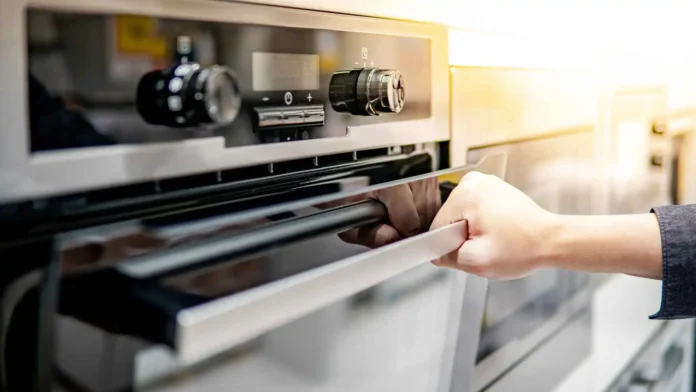Unlocking a self cleaning oven door can be tricky, especially if you’re unfamiliar with the process. Self-cleaning ovens have a built-in locking mechanism to keep you safe during high-temperature cleaning. While this feature is vital for preventing burns or accidents, it can sometimes leave you wondering how to unlock the door once the cycle is complete. In this article, we’ll walk you through why the oven door locks, safety precautions to take before unlocking, common issues you may face, and a step-by-step guide to help you resolve the situation.
Why Does the Self Cleaning Oven Door Lock?
The self-cleaning oven door locks are a safety feature to protect users during high-temperature cleaning. Here are the primary reasons for the lock:
- Safety During High Temperatures
The self-cleaning cycle can cause the oven temperature to reach up to 900°F (482°C). The lock prevents anyone from opening the door and accidentally exposing themselves to these extreme temperatures, which could result in burns or other injuries.
- Accidental Door Opening During Cleaning
While the oven is in self-cleaning mode, the interior becomes very hot, and any attempt to open the door could cause damage or disrupt the cleaning process. The locking mechanism ensures the oven stays securely shut until it’s safe to open.
- Cooling Down Time
After the cleaning cycle finishes, the oven may still be too hot to open. When the oven has cooled to a safe temperature, the lock remains engaged. This cooling period ensures that users aren’t exposed to hazardous heat when opening the oven door.
The self-locking mechanism helps ensure that the oven operates safely and that the door remains secure until it is safe to open.
Safety Precautions Before Attempting to Unlock

Before attempting to unlock the self cleaning oven door, it is crucial to follow a few safety precautions to avoid injury or damage to your appliance.
- Turning off the Oven and Unplugging It: Ensure the oven is completely turned off and unplugged from the power source. This eliminates any electric shock or accidental operation risk while handling the door.
- Ensuring the Oven is Completely Cool: The oven can remain extremely hot after a cleaning cycle. Make sure the oven is completely cool before you attempt to unlock it. This will prevent burns and allow you to handle the appliance safely.
- Avoiding Forceful Methods: Avoid using excessive force if the door doesn’t open easily. Forcing the door can damage the locking mechanism or cause other internal issues. Instead, try troubleshooting methods or consult the user manual for proper instructions.
By following these simple steps, you can ensure your safety and prevent unnecessary damage to the oven.
Common Issues and Troubleshooting Tips
Several common issues can arise when attempting to unlock a self-cleaning oven door. Here are some situations where you should think about getting professional assistance:
- Control Panel Malfunctions: Sometimes, a malfunction in the control panel can cause the self-cleaning cycle to get stuck, preventing the door from unlocking. If you suspect a control panel issue, try resetting the oven by unplugging it for a few minutes and then plugging it back in. If the problem persists, check the control board for error codes or consult the manual for troubleshooting steps.
- Faulty Door Lock Mechanism: A malfunctioning door lock mechanism can prevent the oven door from unlocking after the self-cleaning cycle. If the lock doesn’t release, try waiting longer, as it may still be cooling down. In the event that the door remains locked, check the locking mechanism for visible damage or obstructions. In some cases, the door lock motor may need to be replaced.
- Power Interruptions During the Cleaning Cycle: A power interruption during the cleaning cycle can cause the oven to get stuck in a locked state. In this case, reset the oven by turning it off at the circuit breaker for a few minutes. After restoring power, check if the door unlocks. If not, there could be an issue with the oven’s internal electronics or the lock mechanism.
- Child Lock Feature: Some oven models have a “child lock” feature that prevents the door from opening during certain conditions. If your oven has this feature, check if it’s activated. The manual or control panel should be able to deactivate the child lock. This could be why your door isn’t unlocking after the cleaning cycle.
By addressing these common issues and following the troubleshooting tips, you can often unlock your oven door without needing professional repairs. However, if the problem persists, it may be time to consult a technician for further assistance.
When To Call A Professional
While many issues with a self cleaning oven door can be resolved with basic troubleshooting, sometimes it’s best to call a professional for repairs. Some troubleshooting advice can assist you in fixing them:
- Signs That the Lock Mechanism is Broken: If the oven door remains locked despite following all troubleshooting steps, it could indicate a broken lock mechanism. Common signs include unusual noises, failure to hear the lock’s click, or visible damage to the locking components. A professional can inspect and replace the faulty mechanism, ensuring proper function and safety.
- Persistent Locking Issues Despite Troubleshooting: If you have tried resetting the oven, checking for power interruptions, and waiting for the oven to cool, but the door still won’t unlock, it may be time to call a technician. Persistent issues could be caused by more profound problems with the oven’s internal systems, such as the control panel or wiring, that require professional attention.
- Cost-Benefit Analysis of Professional Repair vs. DIY Fixes: While DIY fixes can save money, some problems are complex and could worsen if not addressed properly. If you have exhausted troubleshooting steps and the issue remains unresolved, weigh the costs of professional repairs against the potential damage from continuing to attempt DIY fixes. Sometimes, professional help is the most cost-effective solution in the long run, especially if it prevents further damage to the oven.
In these situations, calling a professional ensures that the problem is diagnosed and fixed correctly, helping to restore your oven to complete working order.
Fixing Locking Problems in the Future
If you want your self-cleaning oven door to remain functional and avoid future locking issues, you should follow these preventive measures:
- Regular Maintenance and Cleaning of the Oven: Keeping your oven in good condition can prevent many issues. Regularly clean the oven, including the door and lock mechanism, to ensure no grease build ups or debris might interfere with the locking system. Check for any signs of wear and tear and address them promptly to avoid more significant problems.
- Avoiding Interruptions During the Self-Cleaning Cycle: Interruptions during the self-cleaning cycle can cause the oven to get stuck in a locked state. To prevent this, make sure the oven’s cleaning cycle is uninterrupted. Don’t open the door during the cycle, and avoid turning off the stove or cutting power to the appliance before the cycle is complete. This will allow the oven to finish its process and unlock properly.
- Understanding Your Oven’s Manual and Settings: Each self-cleaning oven model has instructions and settings that must be followed for optimal performance. Review the user manual and understand your oven’s self-cleaning cycle, lock mechanism, and safety features. Familiarity with the settings can help you avoid user errors that could lead to locking issues.
By following these tips, you can reduce the chances of encountering locking problems in the future, ensuring your oven operates smoothly for years to come.
Step-By-Step Guide To Unlocking The Oven Door
Step 1: Check if the Cleaning Cycle is Complete
Before attempting to unlock the oven door, ensure the self-cleaning cycle has finished. Most ovens will automatically stop the cleaning process once completed, but there may be a delay before the door unlocks. Look for indicators on the control panel, such as a “Clean” or “Lock” light turning off, indicating the cycle has ended. If the oven is still in the cleaning phase, wait for it to finish before proceeding to the next step.
Step 2: Reset the Oven by Turning Off the Power for a Few Minutes
If the oven door remains locked after the cycle has ended, try resetting the oven. Turn off the power by unplugging the oven or switching off the circuit breaker for a few minutes. This can help reset the internal systems and may release the lock.
Step 3: Use the Oven’s Control Panel to Cancel the Lock
Some ovens have a specific setting to release the door lock. Refer to your control panel and look for an option to cancel or unlock the door. Press the appropriate button to disengage the lock.
Step 4: Manually Unlock Using the Emergency Release Lever (If Available)
If your oven has an emergency release lever near the bottom of the door, use it to unlock it manually. Consult your user manual to locate this lever and follow the instructions for use. This option is helpful when other methods don’t work.
Step 5: Contact Customer Support if the Door Remains Locked
If the oven door remains locked after following the above steps, there may be an issue with the locking mechanism or control panel. Contact customer support for assistance or schedule a professional repair.
FAQs About Self-Cleaning Oven Doors
Q: Why does the oven door stay locked after cleaning?
The oven door stays locked after a self-cleaning cycle to ensure safety. During the cycle, the oven reaches extremely high temperatures to burn off grease and food residue. The lock mechanism engages to prevent accidental openings while the oven is still hot. The door remains locked until the oven has cooled to a safe temperature, typically after the cleaning cycle ends.
Q: Can I unlock the door while the oven is hot?
No, you should never attempt to unlock the oven door while it is still hot. Opening the door prematurely can result in burns or injuries due to the high heat inside. Additionally, forcing the door open could damage the locking mechanism. Before unlocking the door, it’s best to wait until the oven cools to a safe temperature.
Q: How long does it take for the lock to release after cleaning?
The time it takes for the lock to release can vary depending on the model of your oven, but typically, it takes about 30 minutes to an hour for the oven to cool down enough for the lock to disengage. Some models may take longer, especially if the self-cleaning cycle is particularly intense. Always wait for the lock indicator to turn off before opening the door.
Final Thoughts
Unlocking a self cleaning oven door doesn’t have to be stressful; if you follow the proper steps, understand why the door locks, and take necessary precautions, you can troubleshoot common issues and safely unlock your oven. Whether waiting for the oven to cool down, resetting the stove, or using the emergency release lever, most problems can be resolved with patience. However, if you continue to experience issues, don’t hesitate to contact a professional for assistance. Keeping your oven well-maintained and following the manufacturer’s guidelines will help you avoid future locking problems and ensure your appliance operates smoothly for years.



